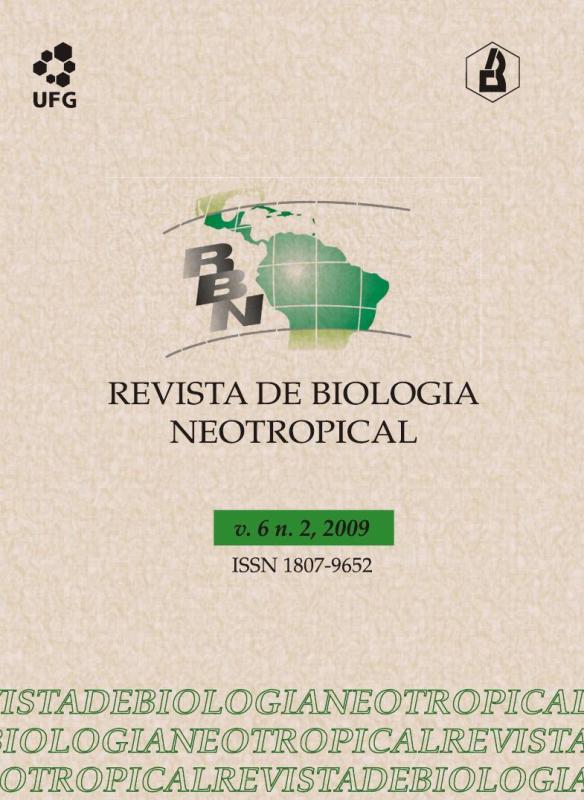Edge effects on epiphytic moss (Bryophyta) communities in the Brazilian Cerrado
Keywords:
Anthropogenic edges, natural edges, bryophytes, Cerrado, forest fragmentation, GoiásAbstract
Microclimatic changes enhanced by the proliferation of edges in fragmented landscapes, known as “edge effects”, may result on shifts in species composition, structure of communities, and ecological processes. Despite the dramatic increase in edge areas caused by anthropogenic habitat fragmentation, the edges and their areas of influence also constitute a relevant structural feature in natural landscapes. This is evident in the Cerrado biome, which is suffering an accelerated degradation and habitat loss and is composed of mosaics of vegetation types that have common boundaries or ecotones. Bryophytes are an ideal group for assessing the edge effects because due to their physiological characteristics, they are vulnerable to microclimatic changes, which makes them particularly useful as indicators of adverse fragmentation effects. This study aimed at assessing how epiphytic moss (Bryophyta) communities respond to forest edges originated from anthropogenic fragmentation and to natural edges in the grassland-foresttransitions in the Cerrado. The areas under study are located in Parque Estadual da Serra de Caldas Novas and its surroundings, encompassing the municipalities of Caldas Novas
and Rio Quente, state of Goiás. Sampling was performed in three habitats: 1) gallery forests on the slopes of the hills with abrupt transitions to rock outcrops fields; 2) edge (0 to 10 m); 3) interior (100 m to 110 m) of seasonal forest fragments surrounded by a grazing matrix. The three treatments considered in the analysis were designated by the abbreviations: BN (natural edge), BA (anthropogenic edge), and IF (interior of the fragment). For each treatment we selected four replicates. Four plots of 10 m x 10 m were randomly delimited along transects of 10 m x 200 m for each treatment in each area. For moss sampling in the plots, we selected all the trees with perimeter at breast height (PBH) ≥ 20 cm and with minimum bryophyte coverage of 300 cm2. For the quantitative moss survey we employed the interception line method. The comparison of Jackknife richness estimates (33.56 for IF, 30.56 for BA, and 25.63 for BN) showed that there was difference only between IF and BN and that moss coverage was significantly higher in BN than in BA (F2,45 = 5.34, p = 0.008). The analysis of similarities (ANOSIM) showed that the moss community was more distinct in BN, and the composition of species in this environment was significantly dissimilar to BA and IF (R = 0.198, p < 0.001). Two factors may explain why the edge effect on species richness and coverage of epiphytic mosses was not evidenced in this study: 1) homogeneity of the vegetation structure observed between edge and interior; 2) this study considered only the mosses, whereas many studies confirm a higher sensitivity of liverworts
to disturbance. Clearer effects were observed between BA and BN, both in coverage and in species composition. This is probably due to differences in spatial and temporal development of these edges, or topographic features of the gallery forests, particularly due to their location in depressions with creeks, which probably provides more moisture to these environments. The chi-square test showed significant differences in the frequency of occurrence of life forms in the different treatments, except for the tuft form. The highest chi-square value occurred for the flabelliform life form, which predominated in BN, collaborating with the evidences already
presented of microclimatic conditions more favorable to mosses in BN, since the flabelliform habit is intolerant to desiccation. This indicates that the use of functional groups of bryophytes as life forms can generate more generalization and help get clearer answers than species richness in the evaluation of the edge effects.
Downloads
Downloads
Published
How to Cite
Issue
Section
License
The expontaneos submmition of the manuscript automaticaly implies in the cession of all patrimonial rights for the Journal of Neotropical Bilogy (RBN) after publication. The autor allow the right of first publication of the article to the RBN, under Creative Commons Attribution 4.0 (CC BY-NC 4.0) Licence.
There are garanties for the authors to the authorial and moral rights, for each one of the articles published by RBN, with permissions:
1. The use of article and contents for the education and researches.
2. The use of the article and their contents, linking to the Article on the web site of the RBN, allowing the divulgation on:
- institutional closed web (intranet).
- open access repositories.
3. Preparation and divulgation of the other publication derived from the article and its content, if there is citation of the original publication by RBN.
4. Make printed copies in small quatinties for personal use.

















